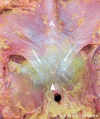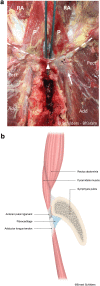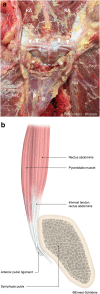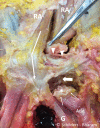The pyramidalis-anterior pubic ligament-adductor longus complex (PLAC) and its role with adductor injuries: a new anatomical concept
- PMID: 28866812
- PMCID: PMC5698379
- DOI: 10.1007/s00167-017-4688-2
The pyramidalis-anterior pubic ligament-adductor longus complex (PLAC) and its role with adductor injuries: a new anatomical concept
Abstract
Purpose: Adductor longus injuries are complex. The conflict between views in the recent literature and various nineteenth-century anatomy books regarding symphyseal and perisymphyseal anatomy can lead to difficulties in MRI interpretation and treatment decisions. The aim of the study is to systematically investigate the pyramidalis muscle and its anatomical connections with adductor longus and rectus abdominis, to elucidate injury patterns occurring with adductor avulsions.
Methods: A layered dissection of the soft tissues of the anterior symphyseal area was performed on seven fresh-frozen male cadavers. The dimensions of the pyramidalis muscle were measured and anatomical connections with adductor longus, rectus abdominis and aponeuroses examined.
Results: The pyramidalis is the only abdominal muscle anterior to the pubic bone and was found bilaterally in all specimens. It arises from the pubic crest and anterior pubic ligament and attaches to the linea alba on the medial border. The proximal adductor longus attaches to the pubic crest and anterior pubic ligament. The anterior pubic ligament is also a fascial anchor point connecting the lower anterior abdominal aponeurosis and fascia lata. The rectus abdominis, however, is not attached to the adductor longus; its lateral tendon attaches to the cranial border of the pubis; and its slender internal tendon attaches inferiorly to the symphysis with fascia lata and gracilis.
Conclusion: The study demonstrates a strong direct connection between the pyramidalis muscle and adductor longus tendon via the anterior pubic ligament, and it introduces the new anatomical concept of the pyramidalis-anterior pubic ligament-adductor longus complex (PLAC). Knowledge of these anatomical relationships should be employed to aid in image interpretation and treatment planning with proximal adductor avulsions. In particular, MRI imaging should be employed for all proximal adductor longus avulsions to assess the integrity of the PLAC.
Keywords: Adductor injuries; Adductor longus avulsions; Anterior pubic ligament; Groin anatomy; Groin pain in athletes; Pyramidalis; Pyramidalis–anterior pubic ligament–adductor longus complex (PLAC); Rectus abdominis.
Conflict of interest statement
Conflict of interest
The authors do not report any conflict of interest for this study.
Funding
The authors want to acknowledge Maimonides Medical Center, Brooklyn, NY, USA, for the grant and use of the facilities and Mrs Maya D. Culbertson for the support with the dissection.
Ethical approval
The study did not represent research with living individuals or the use of protected health information and was declared exempt by our institutional review board. The study was undertaken at Maimonides, Medical Center, Brooklyn, NY, USA.
Figures







References
-
- Anson BJ, Beaton LE, McVay CB. The pyramidalis muscle. Anat Rec. 1938;72:7.
-
- Beaton L, Anson B. The pyramidalis muscle: its occurrence and size in American whites and negroes. Am J Phys Anthropol. 1939;25:261–269. doi: 10.1002/ajpa.1330250236. - DOI
-
- Bell J, Bell C (1816) The anatomy of the human body. Vol I containing the anatomy of the bones, muscles, and joints, the heart and circulation, and lungs. Vol I. 4th edn. Longman, Hurst, Rees, Orme, and Brown, Paternoster-Row, London. T. Cadell and W. Davies, Strand
MeSH terms
LinkOut - more resources
Full Text Sources
Other Literature Sources
Miscellaneous

